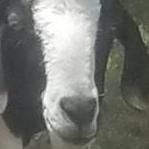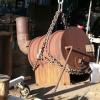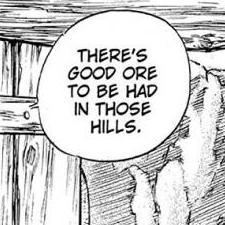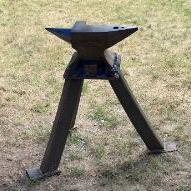-
Posts
9,374 -
Joined
-
Last visited
Profile Information
-
Gender
Male
-
Location
Bradley Oklahoma
-
Interests
Horses, horse drawn equipment, and blacksmithing.
Converted
-
Location
Bradley, Oklahoma
-
Biography
J.O.T., father, son and freind
-
Interests
horses
-
Occupation
farrier
Recent Profile Visitors
-
SLAG started following Charles R. Stevens
-
A 55 talon drum layed on its side and cut in 1/2 for 2/3 of its length, and the cut off used to make the beginnings of a side draft hood works very well, as dose a drum set up on 24” legs (4 deep cement blocks) with this you cut out the side , to leave an 8” deep fire pan and a fire place looking opening that goes just a bit past 1/2 way around (let’s you put long stock all the way threw the fire) and swept in a bit of a curve. tho lots of things work, anything deep enough you can get enough insulation (dirt) to keep from burning out the bottom and large enough to hold the work and a few tools. Fit, I put the blower on the right and reach over it, so I can crank wile manipulating my tongs. Most blowers were for ricotta forges, were you threw the rivet to the riveters to catch in a bucket with your tongs in the right hand
-
Silica sand will melt at forge temp. We call it slag. Sawdust and fire clay in a 1 part to 2 part ratio then fired after completely drying makes a passable fire brick. The sawdust will burn out leaving voids. Otherwise commercial grog. now there are 3 types of fire bricks. Hard non insulitive, soft insulitive and hard insulitive. All take a different grog (non expansive material) for the first one wants ground fired fire clay, the second somthing heat resistant and airy like per light, vermiculite or expanded clay. The last somthing that leaves voids like saw dust or soap bubbles.
-

Brand New Smith, Long Time Lurker.
Charles R. Stevens replied to BadLuckBinks's topic in Introduce Yourself
Jerry, if you wert so dang top heavy you wouldnt land on your head! Binks, 3 sided is a PITA as your not able to poke long stock threw the fire. be aware, I melt hard fire bricks on occasion with charcoal… -
this may have slipped threw the cracks because we see this or a variation of this question so often. All clays are refractory, some are more resistant to heat than others. almost any clay you dig up, find in a road cut, River bank or other formation where you can see the stratification of the soil will work. you can also go to a building supply and buy a bag of fire clay and a bag of builders sand. Mix 2 parts powdered clay to one part sand (there are other grogs that will work well such as ground fire brick, grog from a pottery supply, volcanic ash and diatomic earth to name a few) the sand cuts down on cracks. Wet it, and trow it in a bucket or tub. You want it stuff but evenly moist. It shouldn’t stick to your hands. now fill the forge with clay to with in 2” of the top. This is the hearth. Dig out a bowl about the size of your two fists (cereal bowl) over the tuyere and form a 1” rim around it. mince dry (or close) fill the forge with coal to level. The 2” shallow space holds extra fuel. Now pull the extra fuel in to form a mound over the bowl as you need as much fuel over the material as you do under it. understand that is is for coal, charcoal is a different animal and takes a different hearth shape as the extra fuel will all light. a watering can is recommended to dampen the coal to keep the fire from growing to large and help stick the coke together. hope that helped. refractory cements are expensive and slag sticks like glue to it. man alternative is to fill the forge with fly ash (coal ash) and clinker and reform the bowl as needed. You will still want to keep the ash about 2” below the rim (you will have to remove some ash from time to time to as you form more in the forge. clinker will stick to citified clay as well cut a little wood ash creeps that to a minimum.
-
Hazel and other similar woods are actually twisted to separate the fibers and make it flexible. Infact it can be used as rough cordage. TMI, as pointed out hot stones to boil water pre pottery or metal cooking vessel were most likely handled with just such primitive tongs. The idea that copper was handled just that way is reasonable. Buy the time iron hit the seen , bronze tongs would be in common usage. TP may know what bronze tongs looked like. Many bronze tools looked different than iron tools wile others look much the same.
-
Welcome to the madhouse. Medication on the right, straitjackets on the left.
-

Obtaining UK blacksmith made tools
Charles R. Stevens replied to Bill procter's topic in Tools, general discussion
Have you tried Daniel Moss? He makes tools in the UK and have a pretty good YouTube Chanel. -
To much air can lead to scaling, scale collects and adds to the clinker (as dose old nails in charcoal made from pallets and other scrap, lol)
-

Trying to get back into smithing
Charles R. Stevens replied to Jason L's topic in Blacksmithing, General Discussion
A lot of creative people here that are more than happy to brainstorm up adaptive solutions to over come our shortcomings. not a fan of vice grips for forging, I have never got them to hold right. Welding on rods and good fitting tongs are my friends, as is calling the wife to hold the stock wile I sledge. Forge thralls are so useful. nothing like tendinitis in the the tong arm to make you smarter, lol. -

Near impossible to make a 1/2" frosty burner in the UK?
Charles R. Stevens replied to Simian's topic in Gas Forges
What is the British equivalent to schedule 80 pipe? Same OD but smaller ID (PDC to 1/8”) it is used in higher pressure applications like air compressors between the tank and pressure switch. Hot Rodders have used schedule 80 pipe for frame bosses for years (1/2, 3/8, and 1/4” being the most common as standard bolts fit threw them with out slop). -

What is a side Blast forge like?
Charles R. Stevens replied to Caballo bueno's topic in Solid Fuel Forges
The pot has held up fine to both andracite and charcoal. I would use a larger tuyere for the hair dryer necked down just before it enters the pot. The 5deg down slope pushes the center of the fire away from the tuyere. The wall gets hot otherwise. what hasn’t held up is the bricks, which melt them acasinaly -

How to erase forge weld seam on an Axe
Charles R. Stevens replied to lshindel's topic in Axes, Hatchets, Hawks, Choppers, etc
Let’s make sure we are on the same page, you are using the factory edge lengthwise of the joint? If this is the case then as frosty daisy champ her the edge (and the bit if your doing a tomahawk or battle axe) -

Blacksmithing gems and pearls
Charles R. Stevens replied to Glenn's topic in Blacksmithing, General Discussion
I have one of those in my Samurai. Now just need a cursive font, rotary dial and a round face clock to secure my iPhone. -

How to erase forge weld seam on an Axe
Charles R. Stevens replied to lshindel's topic in Axes, Hatchets, Hawks, Choppers, etc
“Blacksmiths use files” to quote a story TP tells. have you tried grinding out the surface weld seams? Grinding wheels have been in use for centuries. Now like the pattern welded blades you make, if you use a different steel for the eye and bit you will see the difference in appearance between finishes. you can always grind before you finish drawing out or before you begin normalizing in preparation to heat treat for that “rustic” look. -
Being raised buy an Item Okie, “Sweet heart, Honey and Dear come all to easy to the tung and will get you slapped north east and west… Strawberry is generally said in one breathe with Pine, as in Pine-Strawberry, lol












